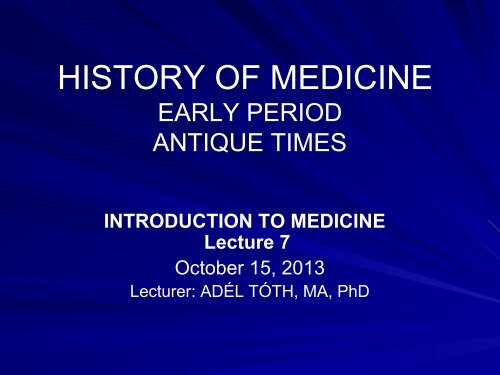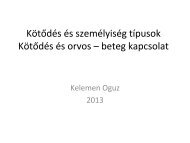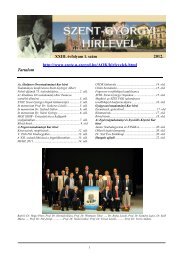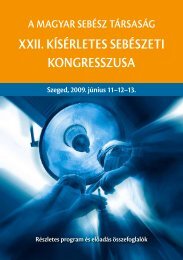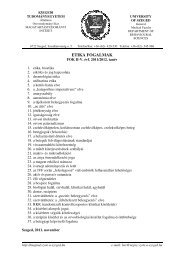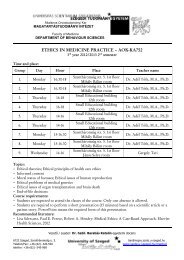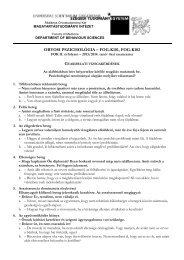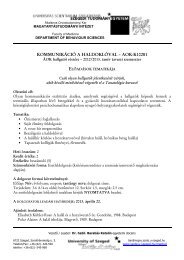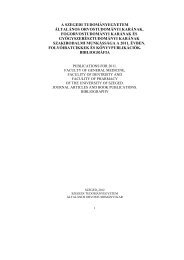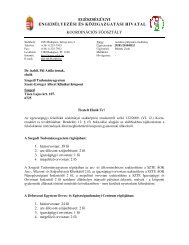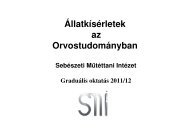Modern concept of health and disease
Modern concept of health and disease
Modern concept of health and disease
Create successful ePaper yourself
Turn your PDF publications into a flip-book with our unique Google optimized e-Paper software.
HISTORY OF MEDICINE<br />
EARLY PERIOD<br />
ANTIQUE TIMES<br />
INTRODUCTION TO MEDICINE<br />
Lecture 7<br />
October 15, 2013<br />
Lecturer: ADÉL TÓTH, MA, PhD
MAIN POINTS<br />
1. Medicine in pre-historic times<br />
2. Ancient Egyptian medicine<br />
3. Medicine in Mesopotamia <strong>and</strong> Babylon<br />
4. Medicine in ancient China<br />
5. Medicine in ancient India<br />
6. Medical knowledge <strong>of</strong> ancient Jewish people<br />
7. Medicine <strong>of</strong> ancient Greece – cradle <strong>of</strong><br />
European medicine, school <strong>of</strong> Hippocrates<br />
8. Physicians <strong>of</strong> the Antique Roman Empire –<br />
Varro, Celsus, Galen
MEDICINE IN PRE-HISTORIC TIMES<br />
Palaeolithic, neolithic people: No<br />
<strong>disease</strong> types unknown today,<br />
devastating <strong>disease</strong>s mild <strong>disease</strong>s<br />
today<br />
Life expectancies: Nomadic tribes:<br />
around 30-35 years for females <strong>and</strong><br />
males<br />
Main factors <strong>of</strong> premature death:<br />
Violent causes, bad weather, other<br />
hardships<br />
Settling down: Appearance <strong>of</strong> infant<br />
<strong>disease</strong>s, various stress factors<br />
Shamans <strong>and</strong> medicine men chased<br />
away the evil spirits causing <strong>disease</strong>s<br />
Most cultures applied trepanation (75%<br />
survival rate)
MEDICINE IN ANCIENT EGYPT - 1<br />
Period between 3300 BC <strong>and</strong> 525 BC (Persian<br />
invasion)<br />
FAITH AND TRUST<br />
- Faith: Curative power <strong>of</strong> magic, charismatic persons<br />
extracted from cosmic harmony, Ecstatic states <strong>of</strong><br />
the healer<br />
- Trust: In the efficiency <strong>of</strong> methods<br />
MEDICINE: Highly advanced; included non-invasive<br />
purging, setting <strong>of</strong> bones, set <strong>of</strong> pharmacopoeia,<br />
magical spells, specific steps <strong>of</strong> examination, diagnosis,<br />
prognosis, treatment - <strong>of</strong>ten rational <strong>and</strong> appropriate<br />
ADVICE TO PRESERVE HEALTH: Wash <strong>and</strong> shave<br />
the body, including under the arms - preventing<br />
infections; Look after diet, avoid foods considered to be<br />
unclean (raw fish)<br />
SUPERNATURAL ELEMENTS OF TREATMENT:<br />
Gods <strong>and</strong> demons to be responsible for many ailments<br />
(<strong>health</strong> related amulets, trust in efficacy: placebo effect)<br />
EARLIEST RECORDED PHYSICIAN: Hesyre, “Chief<br />
<strong>of</strong> Dentists <strong>and</strong> Physicians” for Pharaoh Djoser in the<br />
27th century BC
MEDICINE IN ANCIENT EGYPT - 2<br />
MUMMIFICATION<br />
• No study <strong>of</strong> functional<br />
anatomy: Egyptians never<br />
dissected the body<br />
• Importance <strong>of</strong> heart, but<br />
no idea about circulation,<br />
no distinction between<br />
blood vessels, tendons,<br />
<strong>and</strong> nerves.<br />
• Paleopathology: To<br />
survey the medical state <strong>of</strong><br />
ancient Egyptians <strong>and</strong><br />
their common illnesses
MEDICINE IN ANCIENT EGYPT - 3<br />
EBERS PAPYRUS SCROLL 1550 BC<br />
• Purchased in 1872 by German Egyptologist <strong>and</strong><br />
novelist Georg Ebers, now found in University<br />
Library <strong>of</strong> Leipzig, Germany<br />
• First systematic list <strong>of</strong> medical experience<br />
- Three fields <strong>of</strong> medical activity:<br />
Physicians; chirurgeons; magi, exorcist<br />
- Three categories <strong>of</strong> <strong>disease</strong>s: Symptoms that can<br />
be treated; that can be battled; that cannot be cured<br />
• HEART: Centre <strong>of</strong> blood supply, meeting point <strong>of</strong><br />
numbers <strong>of</strong> vessels that carried all the fluids <strong>of</strong> the<br />
body — blood, tears, urine <strong>and</strong> sperm.<br />
• DISEASES, MEDICAL ACTIVITIES: Depression,<br />
dementia, contraception, diagnosis <strong>of</strong> pregnancy,<br />
other gynaecological matters, intestinal <strong>disease</strong>s <strong>and</strong><br />
parasites, eye <strong>and</strong> skin problems, dentistry, surgical<br />
treatment <strong>of</strong> tumours, bone-setting, burns.<br />
- Asthma: A mixture <strong>of</strong> herbs heated on a brick – a<br />
sufferer could inhale their fumes.<br />
- Death: Half an onion <strong>and</strong> the froth <strong>of</strong> beer - "a<br />
delightful remedy against death."
MEDICINE IN MESOPOTAMIA AND<br />
BABYLON<br />
MEZOPOTAMIA - Clay tablets <strong>of</strong><br />
Assurbanipal (7th c. BC)<br />
• 660 tablets store medical information<br />
• Texts refer to 1000 years earlier period<br />
• Tablets about symptoms, prognosis, <strong>and</strong><br />
the possible treatment<br />
BABYLON – Hammurabbi’s column<br />
(17th c. BC)<br />
• Medical practice: Regulated by laws<br />
• Fees for various procedures precisely<br />
specified<br />
• „If a physician performs major surgery<br />
on a noble… <strong>and</strong> thereby causes his<br />
death … his h<strong>and</strong> shall be chopped <strong>of</strong>f.”
MEDICINE IN ANCIENT CHINA<br />
Traditional Chinese medicine: Based on Taoist philosophical thinking<br />
Health: A condition <strong>of</strong> balance <strong>of</strong> yin <strong>and</strong> yang<br />
• Yang: Immaterial - Qi<br />
• Yin: Material - Blood (very roughly equivalent to physiological blood)<br />
• Free flow <strong>of</strong> Qi, "vital energy”<br />
Acupuncture treatment regulates the flow <strong>of</strong> Qi <strong>and</strong> Blood<br />
• An axiom <strong>of</strong> acupuncture is "no pain, no blockage; no blockage, no pain."<br />
• An acupuncturist decides which points to treat by making a diagnosis by methods<br />
<strong>of</strong>: inspection, auscultation <strong>and</strong> olfaction, inquiring, <strong>and</strong> palpation<br />
Inspection focuses on the face <strong>and</strong> the tongue (tongue size, shape, tension, colour<br />
<strong>and</strong> coating, <strong>and</strong> the absence or presence <strong>of</strong> teeth marks around the edge)<br />
Auscultation <strong>and</strong> olfaction refer to listening for particular sounds (e.g. wheezing)<br />
<strong>and</strong> attending to body odour<br />
Inquiring focuses on the "seven inquiries": chills <strong>and</strong> fever; perspiration; appetite,<br />
thirst <strong>and</strong> taste; defecation <strong>and</strong> urination; pain; sleep; <strong>and</strong> menses <strong>and</strong> leucorrhoea.<br />
Palpation includes feeling the body for tender "ashi" points, <strong>and</strong> palpation <strong>of</strong> the left<br />
<strong>and</strong> right radial pulses at two levels <strong>of</strong> pressure (superficial <strong>and</strong> deep) <strong>and</strong> three<br />
positions Cun, Guan, Chi
MEDICINE IN ANCIENT INDIA<br />
Ajurvedic medicine: Intertwined with mythology <strong>and</strong> religion<br />
Ajurvedic literature created in Vedic period (1700 – 150 BC)<br />
Sushruta Samhita (6 th c. BC) <strong>and</strong> Charaka Samhita (1 st c. BC) –<br />
Influential works on traditional medicine<br />
Five great elements: Earth, water, fire, air <strong>and</strong> space –<br />
forming the universe, including the human body<br />
Balance <strong>of</strong> three substances (DOSHAS): Vata (wind/spirit/air), pitta (bile)<br />
<strong>and</strong> kapha (phlegm), each representing divine forces<br />
Balance in lifestyle: To stay within the limits <strong>of</strong> reasonable balance <strong>and</strong><br />
measure : Moderation in food intake, sleep, sexual intercourse, <strong>and</strong> intake <strong>of</strong><br />
medicine<br />
Charaka Samhita recommends a tenfold examination; Qualities to be<br />
examined: Constitution, abnormality, essence, stability, body measurements,<br />
diet suitability, psychic strength, digestive capacity, physical fitness <strong>and</strong> age<br />
Sushruta Samhita emphasises the proper function <strong>of</strong> body channels<br />
transporting fluids; Lack <strong>of</strong> <strong>health</strong>y channels may lead to <strong>disease</strong> <strong>and</strong><br />
insanity (to rheumatism, epilepsy, paralysis, <strong>and</strong> convulsions); Sweating,<br />
steam bathing, <strong>and</strong> other steam related cures are favoured to open up the<br />
channels <strong>and</strong> dilute the Doshas causing blockages <strong>and</strong> harming the patient.
MEDICAL KNOWLEDGE OF ANCIENT<br />
JEWISH PEOPLE<br />
Old Testament: Health regulations <strong>of</strong><br />
the 8th <strong>and</strong> 3th centuries BC<br />
Foundation <strong>of</strong> public <strong>health</strong><br />
Regulations <strong>of</strong> sanitation, cleanliness<br />
<strong>and</strong> waste-storage - sound even today<br />
To stop epidemics: Forty-day<br />
separation measure (the European<br />
quarantine)
ANCIENT GREECE -<br />
CRADLE OF EUROPEAN MEDICINE - 1<br />
ASCLEPIUS – God <strong>of</strong> medicine<br />
His daughters:<br />
HYGIEIA – goddess <strong>of</strong> <strong>health</strong><br />
PANACEIA – goddess <strong>of</strong> medication<br />
His staff – snakes<br />
Greek philosophy: Basis for the developing<br />
science <strong>of</strong> medicine<br />
Belief in the omnipotent power <strong>of</strong> nature<br />
Emphasis on harmony<br />
The balance <strong>of</strong> the four cardinal humours:<br />
Blood<br />
Phlegm<br />
Yellow bile<br />
Black bile
ANCIENT GREECE -<br />
CRADLE OF EUROPEAN MEDICINE - 2<br />
Emphasis on cleanliness<br />
Usage <strong>of</strong> auscultation, <strong>and</strong> probes to<br />
examine wounds<br />
Emphasis on proper lifestyle<br />
Practice <strong>of</strong> blood-letting, <strong>and</strong> the role<br />
<strong>of</strong> pus<br />
Temple medicine successful in the<br />
treatment <strong>of</strong> psychosomatic <strong>disease</strong>s<br />
TEMPLES:<br />
• Night sanatoriums<br />
• Patients could sleep in beautiful<br />
surroundings<br />
• Could await in their dreams the visit<br />
<strong>of</strong> Asclepius
GREEK PHYSICIANS - HIPPOCRATES<br />
School <strong>of</strong> medicine (5-4th centuries BC,<br />
on the isl<strong>and</strong> <strong>of</strong> Kos, age <strong>of</strong> Pericles<br />
Corpus Hippocraticum – Hippocratic Collection, Hippocratic Oath<br />
Father <strong>of</strong> scientific medicine: Establishing medicine<br />
as a discipline distinct from religion <strong>and</strong> philosophy<br />
Summarising the medical knowledge <strong>of</strong> previous schools<br />
Disease: Not a punishment inflicted by the gods but rather the product <strong>of</strong><br />
environmental factors, diet <strong>and</strong> living habits<br />
Cause <strong>of</strong> illness: Imbalance <strong>of</strong> the four humours in the body<br />
Giving prognosis; Therapeutic approach: Based on the healing power <strong>of</strong> nature; Body has<br />
the power to re-balance the four humours <strong>and</strong> to heal itself; Therapy: Simply easing this<br />
natural process by prescribing rest <strong>and</strong> immobilization; Gentle treatment, keeping the<br />
patient clean (clean water or wine being used on wounds)<br />
Importance <strong>of</strong> observation <strong>and</strong> documentation: Physicians recorded their findings <strong>and</strong><br />
medicinal methods in order to be employed by other physicians<br />
Clinical symptoms <strong>and</strong> devices named after Hippocrates:<br />
• Hippocratic face: Change produced in the countenance by death;<br />
• Hippocratic fingers: Clubbing, a deformity <strong>of</strong> the fingers <strong>and</strong> fingernails<br />
• Hippocratic succussion: Internal splashing noise <strong>of</strong> hydropneumothorax or pyopneumothorax<br />
• Hippocratic bench: A device which uses tension to aid in setting bones<br />
• Hippocratic b<strong>and</strong>age: Cap-shaped<br />
b<strong>and</strong>age
ANTIQUE ROMAN PHYSICIANS<br />
The Greek school in Rome: Based on<br />
the Corpus Hippocraticum<br />
Private practitioners<br />
Family physicians<br />
Health <strong>of</strong>ficers<br />
TERENTIUS VARRO: Ideas about<br />
small invisible creatures causing<br />
<strong>disease</strong>s<br />
CORNELIUS CELSUS:<br />
De Medicina – His description <strong>of</strong> acute<br />
inflammation: Rubor, tumor, cum calore<br />
et dolore (Red, painful, warm swelling)<br />
CLAUDIUS GALENUS<br />
(129-199 AD)
ROMAN PHYSICIANS - GALENUS<br />
GALENUS OR GALEN (129-199 AD)<br />
Born in Pergamon (Asia Minor, Turkey)<br />
Traditional career was planned for him in philosophy<br />
or politics. His father had a dream: The god Asclepius<br />
comm<strong>and</strong>ed to send his son to study medicine.<br />
Studied medicine in Pergamon, Smyrna (Izmir),<br />
Cyprus, Alex<strong>and</strong>ria<br />
Aged 28, returned to Pergamon as a physician <strong>of</strong><br />
gladiators (There, he learnt the importance <strong>of</strong> diet,<br />
fitness, hygiene <strong>and</strong> preventive measures, anatomy,<br />
treatment <strong>of</strong> fractures <strong>and</strong> severe trauma,<br />
Wounds = windows into the body)<br />
Aged 33, launched his medical career in Rome;<br />
Became a personal physician <strong>of</strong> emperors (Marcus<br />
Aurelius <strong>and</strong> his son Commodus, <strong>and</strong> Septimius<br />
Severus)<br />
Followed Hippocratic school: Provided prognosis,<br />
promoted venesection (blood-letting), explanation <strong>of</strong><br />
pathology relied on the four humours theory,<br />
benevolent effect <strong>of</strong> pus
ROMAN PHYSICIANS - GALENUS<br />
Galen's fame rested on his anatomical demonstrations,<br />
performed vivisections <strong>of</strong> numerous animals to study<br />
the function <strong>of</strong> the kidneys <strong>and</strong> the spinal cord<br />
Mistaken ideas: A group <strong>of</strong> blood vessels near the back<br />
<strong>of</strong> the brain (rete mirabile) was thought common in<br />
humans, although absent in humans<br />
Recognition <strong>of</strong> the role <strong>of</strong> blood in feeding tissues:<br />
Identified venous (dark red) blood, originated in the<br />
liver <strong>and</strong> arterial (brighter <strong>and</strong> thinner) blood,<br />
originated in the heart<br />
Mechanism <strong>of</strong> nerve function<br />
Performed operations - brain <strong>and</strong> eye surgeries - that<br />
were not tried again for almost two millennia<br />
Author <strong>of</strong> about 600 treaties (He employed 20 scribes<br />
to write down his words)<br />
Legendary reputation: "Primum sane medicorum esse,<br />
philosophorum autem solum" (First among doctors <strong>and</strong><br />
unique among philosophers. Marcus Aurelius)
ROMAN PHYSICIANS - GALENUS<br />
Islamic culture respected the teachings <strong>of</strong><br />
Aristotle <strong>and</strong> Galen, systematised <strong>and</strong><br />
commented their works<br />
11th century: Latin translations <strong>of</strong> Islamic<br />
medical texts - appeared in Salerno medical<br />
school, later incorporated into teaching at the<br />
universities <strong>of</strong> Naples <strong>and</strong> Montpellier<br />
Galen: the "Medical Pope <strong>of</strong> the Middle Ages"<br />
Determined medicine for 15 centuries –<br />
dogmatic period<br />
Galenic teaching about blood-letting as a<br />
remedy against almost any ailment remained<br />
influential until the 1800s
THANK YOU<br />
FOR YOUR<br />
ATTENTION


